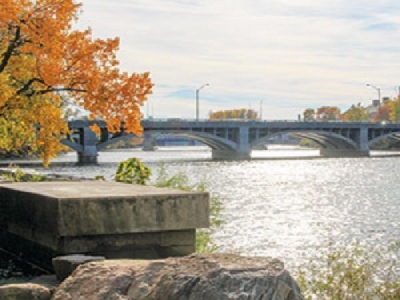
Posted on November 6, 2018
A new study shows dredging a 23-mile portion of the Grand River from the Fulton Street bridge to the Bass River could create a $5.7-million annual economic impact and raise riverfront property values by 16.9 percent.
The state-funded study was completed by East Lansing-based Anderson Economic Group and commissioned by Grand River Waterway, a nonprofit formed last year focused on linking recreational navigational ability on the Grand River from downtown Grand Rapids to Lake Michigan.
This initiative picks up where the Grand Rapids Whitewater initiative to restore the rapids in downtown Grand Rapids stops, according to Shana Shroll, Grand River Waterway executive director.
She said a feasibility study released in 2017 indicated a 50-foot wide, 7-foot deep waterway could be created along that portion of the river, allowing for safe boating on the river.
The U.S. Army Corps of Engineers considers the full, 40-mile leg of the river from downtown Grand Rapids to Grand Haven as a navigable waterway.
While the 17-mile Grand River stretch from Grand Haven to Bass River has been open and maintained in recent history, Shroll said these 23 miles — just downstream from Eastmanville to Fulton Street in downtown Grand Rapids — are unsafe for navigation by recreational shallow draft boats.
“The problem with the river … is that you don’t know how deep it is until you’re already there because of the sediment that’s just built up over the years,” Shroll said.
Shroll said the dredging would be much less invasive than the downtown Grand Rapids project. It involves only an initial removal of sediment and then continuous maintenance.
The 2017 feasibility study showed removing 100,000 cubic yards of material over the 23 miles would allow for navigability. The projected cost from that study was a one-time $2.15-million dredging cost, with estimated yearly maintenance costs of $165,000.
Cristina Benton, the Anderson Group’s director of market and industry analysis, said the $5.7-million impact estimate comes from estimating sales generated by the restored rapids, such as recreational activities, hotel stays and restaurant visits.
The study estimates the project would bring about 33,000 new visitors annually who would stay 1 1/2 days in the region and spend an average of $125 per day.
With 77,000 registered boats in Kent and Ottawa counties, boater surveys show 37 percent of Michigan residents participate in recreational boating.
Benton said the estimate does not include other impacts that could stem from increased river activity. This includes a potential increase in property value within 2,000 feet of the river of $27.2 million in state equalized value, a true cash value of about $54.4 million. This could create an annual increase of $614,000 in tax collections for municipalities, she said.
This also could include additions of private docks, boat purchases and construction of additional boat slips.
The study said the construction of 500 to 1,000 slips built over the next 10 to 15 years could generate between $7.5 million and $60 million in construction spending.
According to boat owner surveys, owners could spend between $5,000 and $7,000 per boat per year for boats under 40 feet, and between $20,000 and $30,000 per boat per year for boats over 40 feet.
Rick Baker, president of the Grand Rapids Chamber of Commerce, said the modest investment it would take likely would have exponential results.
“The economic impact study only begins to scratch the surface of the potential residential and commercial benefits all along the river,” Baker said.
While the official initiative to dredge this waterway is new, Shroll said the idea has been around for a while. In 1978, the federal government did a study to learn what it would take to make the river navigable, though she said it’s unclear why nothing happened from there.
She said the 1978 study was uncovered around 2011 when Grand River Waterway founders wondered why there weren’t more boats on the river.
Shroll said the project still is in the early stages, and the next step will be to study the environmental impact.
Funding also is yet to be determined, though Shroll is hoping for a mix of public and private contributions.
With this kind of project, there are always a lot of hoops to jump through, which she said is good for the public overall, but it means there is a lot of work before any action can take place.
“Nobody’s dredging anything right now. We’re still in fact-finding mode,” Shroll said.
Source: grbj





